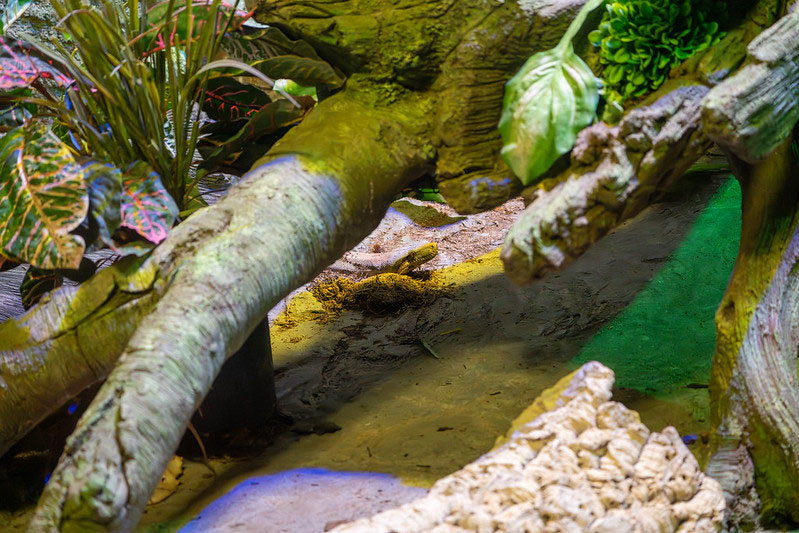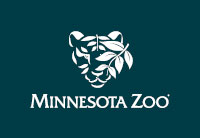Some special sister snakes are turning into teens! On July 16, 2025, the Minnesota Zoo is celebrating the 13th birthdays of Hog Island boas Harley and Esmeralda. They are the two biggest snakes at the Zoo in length and weight – and are big ambassadors for their species.
Harley lives in the nocturnal (dimly lit) portion of the Tropics Trail. She also sometimes participates in educational programs. You can meet her sister Esmeralda in the Wings & Things! Show and in pop-up encounters on the Upper Plaza.
Zookeeper Matt Detjen knows these snakes well, as they work together on the Animal Ambassadors team to bring educational programs to guests.
He describes Harley as the “cool, calm, and collected older sister.” She is 6 feet long and fully grown.
“Esmeralda is a little more stylish, sassy, and attention-demanding,” he says.

Outreach Naturalist Jean Magle and Hog Island boa Esmeralda with a class of students at the Minnesota Zoo. Boas are excellent climbers and the colorful climbing grips offer Esmeralda a way to scale the vertical board.
Both came from the Bronx Zoo as young snakes in 2012. They are “pretty in pink” with pastel, patterned scales. Due to this camouflage, Harley can be hard to spot in her habitat. Take your time when traveling the Tropics Trail – she’s worth looking for!
Hog Island boas (Boa imperator) are an endangered species native to two of the Cayos de Cochinos Islands off the coast of Honduras. These boas inhabit only about 1 square mile of land in the entire world.
Hog Island boas are endangered because they were taken in large numbers for the pet trade in the 1970s and 80s. Since the Honduran government added protections in the 1990s, the population has slowly rebounded. Besides wildlife trafficking, they also face the threat of habitat destruction due to invasive species and pressures of tourism on small islands.
Down the Hatch
Boa constrictors, like Harley and Esmeralda, are nonvenomous snakes. In the wild, boas capture prey animals by ambushing them at night; they quickly grab them and wrap them in their powerful coils to suffocate it within minutes. Once the animal is dead, the boa swallows it whole using a technique called jaw-walking. Large prey makes a visible bump in the snake’s body as it slowly moves through the digestive tract.
Detjen says Harley and Esmeralda eat rodents every other week. Wild boas can go 1 to 2 months after eating a large prey animal, like an agouti. Typical prey includes small mammals, birds, and lizards. By controlling the rodent population, boas help protect crops and are essential to maintaining a healthy ecosystem.

Harley, a Hog Island boa, in her habitat on the Tropics Trail of the Minnesota Zoo. In the wild, the boa’s pink patterned scales help them camouflage in the tree branches and on the rainforest floor.
Snake Stars of the Show
“I love seeing kids get excited about meeting snakes,” Detjen says. “Kids’ enthusiasm helps adults who are wary get more comfortable and curious.”
“’Are they venomous?’ is the most common question we get,” he says. “None of the snakes at the Zoo are, and in the wild in Minnesota only the timber rattlesnake is and it’s very rare in southeast Minnesota.”
He says it’s important to always give wild snakes respect and space. The Zoo is a wonderful place to see snakes closely and safely.
At many Treetop Trail Animal Encounters, Detjen says you can see snakes exploring tree branches or the “jungle gym,” a vertical board with climbing grips that snakes weave around and move upwards through.
The Wings & Things! Show offers even more movement, not only from snakes but other reptiles, birds, and mammals. Presenters encourage guests might reflect on how differently animals see our shared world – and what we all have in common.
Every show is different, and animals can “throw curve balls,” he says. “You don’t know who’s going to come around the corner… or who will choose to do their own thing.”
Detjen recommends guests stay after the show and come down to the front of the theater to ask questions and see animals up close.
Wings & Things! is offered daily at 10:30 a.m. and 2 p.m. in the Target Learning Center. The show is included with your admission thanks to our sponsor Wings Credit Union. Enjoy 20 minutes of education and entertainment as we share the lives (and antics) of animals.




Get Social